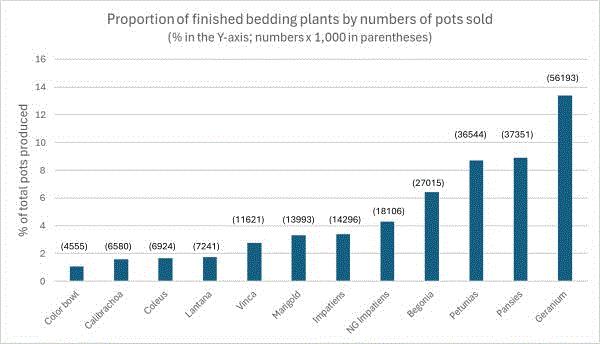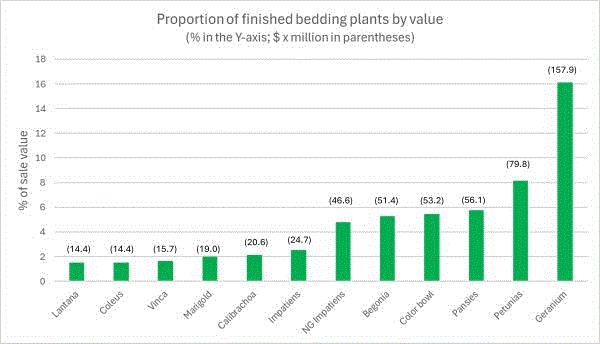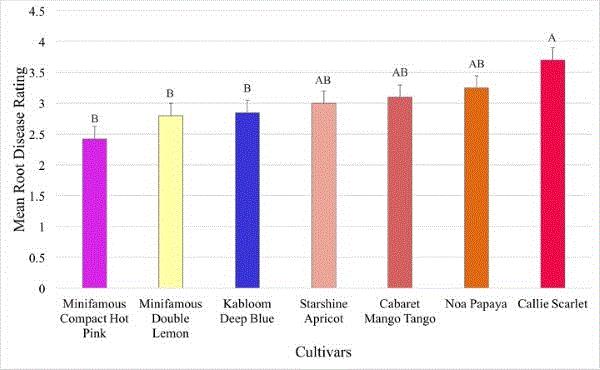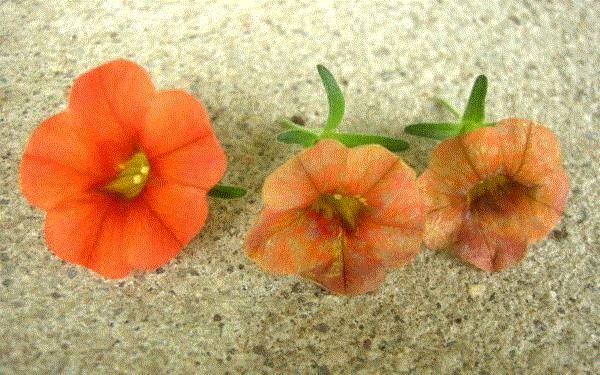JC’s Not-So-Secret Obsession With Numbers
Several inquiries about calibrachoa have come into my message and email inboxes. It’s not just me. Apparently, y’all have been talking to my friends, colleagues and competitors as well. (Yes, we gossiped among ourselves, so don’t think your complaints and hopefully praises for me won’t reach me eventually.)
I’m already on the lookout for information about calibrachoa. When Bill Calkins dropped his Tech On Demand newsletter last Friday, his “Nick’s Tip of the Week” focusing on calibrachoa and petunia abnormalities immediately drew my attention. Bill started this segment with the statement, “As you all know, petunias and calibrachoas make up a major proportion of spring annuals in North American greenhouses every year.” I was like, “Really?”
My wife is quite familiar with my “Really?” face. She sees that face whenever we exchange information from various online sources or anything that has to do with numbers—the sale price of the house down the road, the weight of her dog, the distance from Charleston, South Carolina, to Saint Thomas, the U.S. Virgin Islands, etc. It must be very hard to be my wife. (Conclusions, if you care to know: Our neighbor is smoking something to ask for that much for that house; my wife’s dog just has big bones; and St. Thomas is far. Like, we can’t drive there.)
I can’t help it. I’m a numbers guy through and through. That face of mine isn’t a repudiation of any facts or numbers shared by my lovely wife, Bill or anyone. Words such as “majority,” “most” and “a few” don’t hold much meaning to me. How many are “the majority” exactly? The best way to convince me of something is to show me the numbers. Better yet, run some statistics on the numbers and show me that there’s a significant difference at a level of 5%. (I know, I’m hopelessly poisoned by academia.)

Millions of Bells Ringing Cha-Ching!
How important is calibrachoa as a crop? I’m not trying to see if it's indeed one of the major floricultural crops; my eyes confirm that fact in every greenhouse I visited this spring. I want to see exactly how important calibrachoa is by the numbers.
There isn’t a summary of calibrachoa-nomics. Disappointingly, Bing (even with the assistance of the AI model Prometheus) wasn’t much help with this research, so I had to crunch the numbers myself. I held my nose and dove into the deep sea of the 2019 Census of Horticultural Specialties by USDA National Agricultural Statistics Service and pulled out “Table 6 Annual Bedding/Garden Plants Sold—Pots.” I chose this table to focus on finished crops and I used the “all pots” dataset to account for all plants produced regardless of the pot size. This table doesn’t group crops by their growing seasons.
Let’s start with the baseline: A total of 5,482 operations were included in the survey results for flowering and foliage annuals. Collectively, these operations sold 420 million potted annual bedding or garden plants, which were worth nearly $982 million.


Geranium was the No. 1 crop among the potted flowering and foliage annual plants produced and identified in the 2019 census. Calibrachoa made up 1.6% of all plants sold (nearly 6.6 million pots) and 2.1% of the total value (about $21 million). Petunia took up 8.7% of the number of plants sold and 8.1% of the value. So Bill is right: Calibrachoas and petunias make up over 10% of a major portion of floricultural crops. The proportion is even higher if you only consider spring crops.
This is just an exercise with rough calculations of available data to satisfy my curiosity. If you’re an economist reading this newsletter, please give me a break for mercy’s sake. (Thanks for reading, by the way.) I’m an entomologist with only one class in Economics 101 under my belt, so don’t expect that much from me.
By the way, you’ll notice that the data were from the 2019 Census of Horticultural Specialties. A bit outdated. There's a new round of census going on right now. If you received a survey request, please don’t ignore it. You can still contribute to the census by going HERE to complete the survey (have your survey code ready). The deadline to contribute has been extended to April 18. Results from the new census will be available on December 16, 2025.
That’s the end of my public service announcement. Now, onto the bugs and diseases of calibrachoa so y’all will be prepared for any pest and disease management challenges as we inch towards Mother’s Day.

Everything About Calibrachoa is Cultural
No joke! How y’all grow calibrachoa will determine how many pest and disease problems your crop gets. I believe that a healthy plant is also the one that’ll stand up to pest and disease challenges, so don’t just skip this section and go straight to the sections below.
Quite a bit has been written about growing a successful calibrachoa crop. Go HERE for Nick Flax’s takes on how and what to watch for in terms of media pH and EC. You want to keep the pH between 5.4 and 5.8, and EC between 0.6 and 0.9. An easy way to avoid problems related to EC is by achieving the fertility recommended by breeding companies of the series or cultivars you’re growing. And don’t be shy about using your pH and EC meters. You also want to grow calibrachoa under high light level, avoid overwatering, and provide good drainage and air circulation.
What happens when you deviate from these optimal growing conditions?
Growing calibrachoa in early spring can be tricky. It’s particularly tricky for folks in the northern states where the sun doesn’t shine all day and the glaciers haven’t retreated. All you want to do is to close the greenhouses to save on the heating bill, but that means poor air circulation and the media stays wet longer. The optimal growing temperature for many calibrachoa series is between 55F and 65F, which coincidentally, is also the optimal temperature for black root rot infection. The challenging growing environment conspires with the burning, but unexplained urges to water (every single day) creates optimal conditions for root rot disease outbreaks.
Watch your media pH to avoid diseases and nutrient deficiencies. As noted by Nick, black root rot can become an issue for calibrachoa once pH exceeds 5.8. You’ll also run into nutrient (particularly iron) deficiencies at higher than optimal pH.
Manipulating fertility may help prevent diseases. For example, using fertilizer high in ammonium, but low in potassium, may help keep black root rot incidences low. While low fertility doesn’t necessarily prevent infestation, high nitrogen contents are known to promote population growth in aphids and other insects. Again, grow your calibrachoa at the recommended fertility to make sure the plants can perform well.

Relative black root rot severity on seven calibrachoa cultivars. The severity presented is an average caused by six isolates of the pathogen. (Source: Lindsey Becker and Marc Cubeta, Plant Disease Management Report March 2019.)

Relative black root rot severity on five calibrachoa cultivars. The severity presented is an average of five isolates. (Source: Ann Chase, GrowerTalks October 2023.)
Cultivar selection also plays a role in disease management. (Entomologists haven’t looked too deeply into how different calibrachoa series respond to insect pests, such as aphids.) Two graphs above demonstrate that cultivars are different in their susceptibility to black root rot. Margery Daughtrey also reported that the Cabaret series (Red, Cherry Rose, Apricot, White, Scarlet and Purple), the Superbells series (White, Pink Kiss, Trailing Rose and Blue), and the Million Bells series (Cherry Pink and Crackling Fire) have higher resistance than Million Bells Terra Cotta (go HERE for a summary of the 2006 report). While these studies don’t include some of the most recent cultivars, you can always ask for disease resistance information from the breeding companies that supply the cultivars you’re growing.
Growing your calibrachoa properly can help you avoid a lot of pest and disease problems.

Diseases of Calibrachoa
While some viral diseases (such as Tomato Mosaic Virus and Calibrachoa Mottle Virus) and oomycete diseases (Pythium and Phytophthora root rots) can be issues at times, black root rot and powdery mildew are by far the most common diseases I’ve seen. It’s interesting how, even after so many new calibrachoa cultivars have been introduced, these two diseases are still the most prevalent.
I talked about how the growing conditions in early spring are optimal for black root rot in the last section. I hope y’all will now monitor your pH and EC more carefully to prevent black root rot outbreaks. Also watch your irrigation so that the plants aren’t going between the extremes of wilting and drowning.
Two of the most important management approaches I didn’t previously talk about are the need to sanitize (particularly the benches) and use clean or unused media, pots and trays. This approach isn’t only for black root rot—it’s also for Pythium and Phytophthora, too. This is because spores of these root rot diseases can be transferred from one crop to the next on media, pots, trays and benches.
Root rot diseases can often be introduced via plugs. Therefore, you may have to apply a preventive fungicide drench immediately after transplant. Thiophanate methyl (FRAC 1) and FRAC Group 3 fungicides (such as mefentrifluconazole or Avelyo, metconazole or Tourney, and triflumizole or Terraguard) have been the work horses of black root rot management programs. To avoid resistance, these products should be rotated with fungicides in Group 7+11 (many products), 12 (such as fludioxanil or Medallion) and 19 (such as polyoxin-D or Affirm), and others. Go HERE for an article on black root rot management.
Chat with your favorite extension specialists or pathologists on products effective against Pythium and Phytophthora. Note that the same fungicides aren’t equally effective against these two diseases, even though they’re both oomycetes.
 Powdery mildew symptoms are expressed on the flowers in the middle and on the right-hand side. (Photo credit: Neil Mattson, Cornell University.)
Powdery mildew symptoms are expressed on the flowers in the middle and on the right-hand side. (Photo credit: Neil Mattson, Cornell University.)
Powdery mildew can infect both leaves and flowers. On the leaves, this disease expresses the same powdery symptoms as on other crops. But the symptoms look rather interesting on flowers. I didn’t recognize the blotchiness symptom on the flowers the first time I’d seen it. The early symptom of powdery mildew infection—thinning or dying lower leaves—may not be conspicuous. But when given the right conditions to continue (high humidity and cool temperatures), powdery mildew can spread quickly. (Go HERE and HERE for nice pictures of disease symptoms and progression.) Increasing plant spacing can help lower humidity and slow down spread. Fungicide applications are needed to prevent infection and outbreaks.
Go HERE for a quick cheat sheet on managing black root rot, powdery mildew, Pythium and Phytophthora from Colleen Warfield, a pathologist at USDA.

Bugs of Calibrachoa
There's a little parallel going on between the bugs and the cruds of calibrachoa. The most prevalent diseases are black root rot and powdery mildew; the most prevalent insect pests are fungus gnat and aphid. In both cases, one lives in the media and the other in the canopy.
Sure, I see thrips on calibrachoa, but in my experience thrips only cause damage and become a problem in the flowers. Hopefully, insecticide sprays and preventive releases of biological control agents can keep thrips at bay and their damage minimal.
There are effective insecticides and biological control solutions for managing aphids and fungus gnats. When managing fungus gnats, targeting larvae in the media is the key to success. This can be done by keeping the media on the dry side (this benefits calibrachoa growth, too), and by drenching or sprenching neonicotinoids, azadirachtin, insect growth regulators and beneficial nematodes.
Aphids aren’t hard to kill; most insecticides registered for their control usually work well as long as you can treat the population when it’s still small. (Go HERE to get free copies of insecticides posters that I’ve recently published and see what you can use for these pests.)

Potato aphids and mummies on calibrachoas. (Photo credit: Tina Smith, University of Massachusetts.)
When plants are grown on benches, these pests aren’t difficult to treat either by spray or by drench. When the pots are hung up, as we often do with calibrachoa, or you have mixed combos, treatment application becomes a bit trickier. The hanging baskets are “out of sight, out of mind.” Often, we finally realize there's a problem when winged aphids or adult fungus gnats are flying all over the place.
Drench or sprench of insecticides works well for fungus gnats and aphids, but treatment must be done before hanging the baskets up. (It’s messy to drip insecticide solution after the baskets are hung in line.) For drenches against aphids, neonicotinoids (if you could and want to use it; IRAC 4A), Altus (flupyradifurone; 4D), Kontos (spirotetramat; 23) and Mainspring (cyantraniliprole; 28) are the most commonly used products. Many products are effective when sprayed against aphids, but the insecticides will have a hard time reaching the hanging baskets. Biological control may be a good solution in this case. Go HERE to read an earlier issue of this newsletter where I talked about managing aphids on hanging baskets.
Have a great crop this spring! Reach out to me if you run into trouble or have questions.




See y'all later!

JC Chong
Technical Development Manager at SePRO
Adjunct Professor at Clemson University
This e-mail received by 27,847 subscribers like you!
If you're interested in advertising on PestTalks contact Kim Brown ASAP!